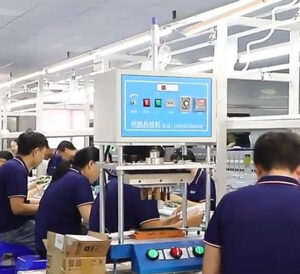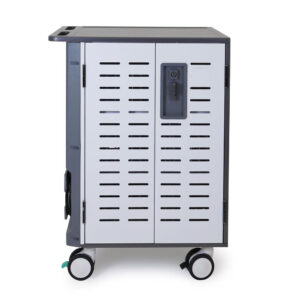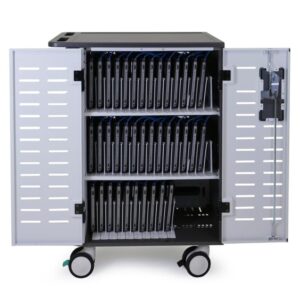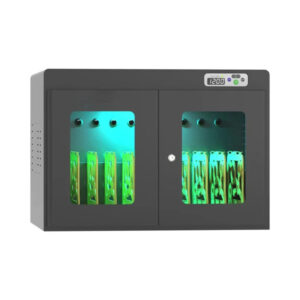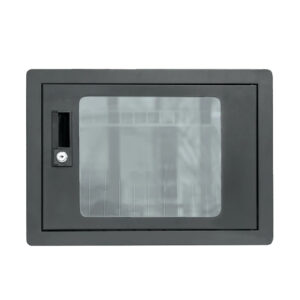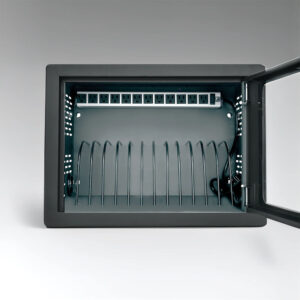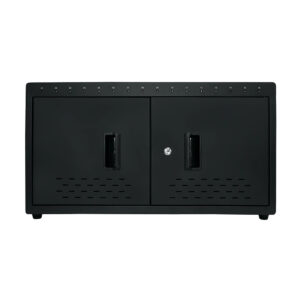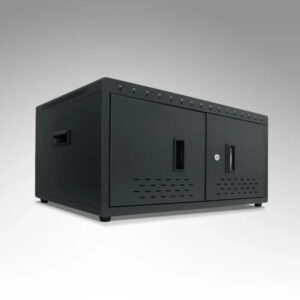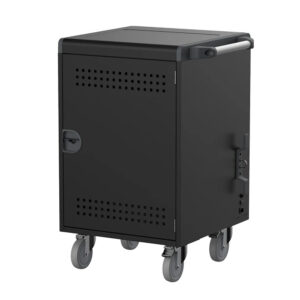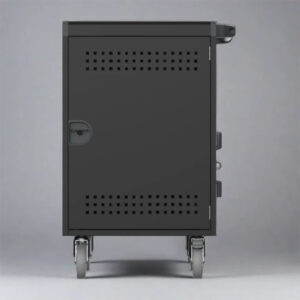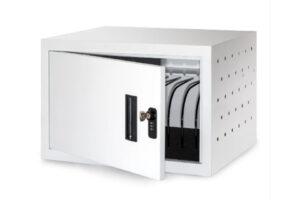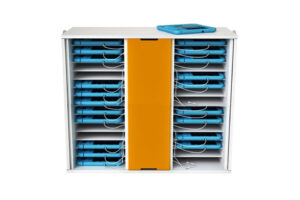Summary
Medical grade charging cabinets are specialized storage solutions designed to meet the unique power management and hygiene needs of healthcare environments, operating continuously to support patient care around the clock. These cabinets are increasingly recognized for their role in enhancing the efficiency and safety of healthcare operations, particularly in settings where the risk of healthcare-associated infections (HAIs) is a significant concern. Their design incorporates advanced electrical systems that allow for safe charging of multiple medical devices while ensuring compliance with stringent safety standards such as IEC 60601-1 and ISO 13485, making them essential for both clinical and administrative workflows.
The prominence of medical grade charging cabinets stems from their dual focus on hygiene and operational effectiveness. These cabinets feature antimicrobial surfaces and are constructed from materials designed for easy cleaning, which is vital for infection control in hospitals and clinics. They offer organized storage solutions that help streamline the handling of medications and medical supplies, thereby minimizing the risk of errors during patient care. Moreover, the ergonomic design of these cabinets promotes user comfort, allowing healthcare providers to access equipment without straining, thus supporting better care delivery during high-pressure situations.
Despite their advantages, the integration of medical grade charging cabinets into existing healthcare infrastructures poses challenges, including the need for compliance with diverse regulatory requirements and the potential disruption of established workflows. Additionally, the ongoing maintenance costs and necessary training for staff to effectively use these cabinets can present financial and operational hurdles for healthcare facilities. The balance between technological innovation and practical application remains a key focus area for stakeholders as they aim to enhance both patient safety and healthcare provider efficiency.
In summary, medical grade charging cabinets represent a critical advancement in the intersection of healthcare technology and hygiene management, playing a pivotal role in modernizing healthcare delivery while addressing significant public health concerns. Their continued evolution reflects the growing emphasis on safe, efficient, and hygienic care environments in the ever-demanding landscape of healthcare provision.
Table of Contents
Features
Medical grade charging cabinets are designed to enhance both power management and hygiene within healthcare environments. These cabinets are equipped with a range of features that ensure safe and efficient operation while maintaining high standards of cleanliness.
Ergonomic Design
The cabinets prioritize user comfort and efficiency with ergonomic adjustability, allowing healthcare providers to work comfortably whether seated or standing. This design consideration supports prolonged use without compromising provider well-being.
Organized Storage Solutions
These charging cabinets come with multiple storage compartments, including bins and drawers, which facilitate easy organization of medications and supplies. This organized approach not only enhances workflow efficiency during medication administration but also aids in ensuring that controlled substances and sensitive materials are securely stored.
Advanced Electrical Systems
A key feature is the built-in electrical system, which allows for the safe charging of multiple batteries and includes several power points. This system is compliant with IEC 60601-1 standards, making it suitable for use inside and outside patient care areas. Furthermore, it supports various battery types, including SLA and LiFePhos, to meet specific power requirements effectively.
Infection Control Considerations
The cabinet surfaces are designed for easy cleaning and are often made from materials that support effective cleanability. For instance, many workstation surfaces are covered with a 3D laminate or thermofoil that can withstand regular cleaning protocols without damage. Additionally, materials with antimicrobial properties are increasingly being incorporated, which inhibit the growth of microorganisms on surfaces, thus enhancing infection control measures.
Customization and Scalability
The cabinets offer customizable accessory options, such as glove dispensers and sharps containers, which further streamline operations within care settings. They are also designed to be scalable, supporting the requirements for both short and long telehealth sessions, thereby facilitating a variety of healthcare delivery models.
Compliance and Safety Certifications
Manufacturers of these medical grade charging cabinets adhere to strict standards, including ISO:13485 certification, ensuring products are designed and manufactured to high-quality benchmarks. Rigorous testing processes, including those for MET certification, ensure that the cabinets meet required standards for accuracy, safety, durability, and reliability.
These combined features make medical grade charging cabinets an essential component in the provision of effective, safe, and hygienic healthcare services.

Hygiene Standards
Importance of Hygiene in Healthcare
Maintaining rigorous hygiene standards in healthcare settings is essential to prevent healthcare-associated infections (HAIs), which pose significant risks to patient safety. A comprehensive infection prevention program is vital, addressing potential reservoirs in the chain of infection, such as environmental surfaces and shared medical devices. Healthcare environments must implement effective policies for cleaning and disinfection, ensuring that all equipment and items used in patient care are handled and stored safely.
Cleaning and Disinfection Protocols
Cleaning medical equipment is governed by a regulatory framework that varies by country and is enforced by health agencies. In the United States, the Food and Drug Administration (FDA) oversees the safety of medical devices, mandating adherence to Good Manufacturing Practices (GMP) for cleaning and disinfection.
Pre-cleaning: This initial step involves removing visible debris and organic matter from medical equipment, which is crucial for effective subsequent cleaning and disinfection.
General Cleaning: Utilizing appropriate cleaning agents, methods such as manual washing, ultrasonic cleaning, and rinsing are employed to eliminate all contaminants.
Disinfection: After cleaning, disinfection is performed using suitable agents to eradicate any remaining pathogens. Proper contact time and method adherence are critical for ensuring efficacy.
Role of Antimicrobial Surfaces
The implementation of antimicrobial surfaces within healthcare facilities represents a significant advancement in infection control. These surfaces are treated with antimicrobial agents that inhibit microbial growth, reducing the risk of organism transmission. For instance, copper and its alloys have demonstrated natural antimicrobial properties effective against a range of pathogens, including methicillin-resistant Staphylococcus aureus (MRSA) and Clostridioides difficile.
Training and Compliance
To minimize infection risks associated with hygiene lapses, healthcare providers must be adequately trained in infection prevention behaviors. Studies have shown that healthcare personnel often commit errors related to preventive hygiene, occurring approximately every five minutes during patient care. Continuous education and adherence to hygiene protocols are necessary to cultivate a culture of safety in healthcare settings.
Documentation and Regulatory Compliance
Thorough documentation of cleaning processes is critical for compliance with regulatory guidelines, as outlined by agencies like the FDA and the Joint Commission. This documentation serves not only to validate that cleaning procedures are correctly executed but also to mitigate liability for manufacturers in case of device-related incidents. Proper maintenance of cleaning equipment and solutions is also necessary to prevent extrinsic contamination, which can undermine infection control efforts.

Applications
Medical-Cart Computers
Medical-cart computers are integral to modern healthcare environments, particularly in clean-sensitive areas such as Intensive Care Units (ICUs), Neonatal Intensive Care Units (NICUs), and operating theaters. These fanless devices are designed to support various applications through their powerful CPUs and advanced graphics capabilities, enhancing clinical workflows and patient care delivery.
Imaging and Diagnostics
The robust processors in medical-cart computers facilitate the rapid rendering of complex medical images, such as X-rays and MRIs. This capability allows radiologists and clinicians to analyze scans in real-time at the point of care, significantly improving diagnostic efficiency and decision-making processes.
Real-Time Monitoring
In critical care settings, medical-cart computers seamlessly integrate with patient monitoring systems, providing dynamic visualizations that enhance clinical decision-making. This integration allows healthcare professionals to monitor patient vital signs in real-time, which is essential for timely interventions and preventing complications.
Documentation and Charting
These systems enhance documentation practices by providing healthcare staff with easy access to electronic medical records. This access fosters collaboration among medical specialists, enabling informed clinical decision-making based on comprehensive and up-to-date patient data. Consequently, the patient experience improves due to the personalized care delivered at their bedside.
Mobile Workstations
The Trio Computing Workstation exemplifies the innovative design of mobile medical carts. It features a lightweight, ergonomic design that promotes maneuverability and ease of use in various care settings. This workstation is equipped with a scalable power system, enabling healthcare providers to meet runtime requirements effectively, thereby enhancing operational efficiency.
Storage Solutions
Efficient storage solutions play a crucial role in maintaining patient safety and care quality. Multiple storage compartments in medical carts, including bins and drawers, ensure that medications and supplies are organized and easily accessible. The inclusion of customizable accessories, such as glove dispensers and sharps containers, further streamlines workflow during medication administration.
Security and Compliance
The use of locking systems in medical carts provides secure storage for controlled substances and sensitive materials, ensuring compliance with safety regulations and preventing unauthorized access. This security measure is vital for maintaining the integrity of healthcare operations and safeguarding patient care environments.

Case Studies
Hospital-led Initiatives for Hand Hygiene
A prospective study conducted in several healthcare facilities highlighted the variability of hospital-led unit-based initiatives aimed at improving hand hygiene compliance. In many instances, frontline healthcare providers took the initiative to enhance awareness by creating signage, leading coaching sessions, and serving as “hand hygiene champions” during shifts. Additionally, the implementation of weekly “HH performance improvement calls,” also known as “HH accountability calls” or “HH huddles,” facilitated discussions on performance rates and action plans involving ancillary departments when applicable.
Vendor Support in Hand Hygiene Improvement
The study differentiated between two intervention groups: the AHHMS-alone group and those that incorporated clinician-based vendor support. The latter included on-site assistance from vendor-employed nurses with substantial hand hygiene improvement experience, which was tailored to the specific needs of each hospital. Activities often involved ongoing education, workflow optimization, and barrier identification. Remote support also played a role, including data analysis and phone conferences to bolster hand hygiene leadership efforts.
Challenges and Solutions
Despite the best intentions, the integration of proper hand hygiene practices faced challenges due to the complexities of the healthcare environment. Issues such as poorly designed products, uncoordinated care processes, and fragmented systems were identified as factors leading to mistakes. A key recommendation was for healthcare organizations to address environmental obstacles strategically, rather than relying solely on personnel memory and focus.
Furthermore, heavy workloads and unclear responsibilities often led to lapses in cleaning and disinfecting high-touch areas. This indicated a need for clearly defined roles and sufficient staffing to ensure infection control practices were consistently followed.
Impact of Technology on Hand Hygiene Compliance
An innovative case study demonstrated that technology could significantly enhance hand hygiene compliance in hospital settings. The use of an Automated Hand Hygiene Monitoring System (AHHMS) not only provided real-time data but also facilitated communication among healthcare providers, thereby improving adherence to hygiene protocols.
Certification Programs for Medical Device Users
Effective certification programs are essential for ensuring safe patient care in hospitals. A structured path for medical devices, which includes device classification, risk assessment, and regulatory submission, ensures compliance with safety and efficacy standards. A streamlined certification process, bolstered by platforms that track progress and automate notifications, plays a critical role in enhancing the safety of medical device usage within healthcare settings.
Through these case studies, it is evident that a multifaceted approach involving both technological solutions and active participation from healthcare providers can lead to improved hygiene practices and patient safety in healthcare environments.

Market Overview
The global medical device market is experiencing significant growth, projected to increase from $471 billion in 2020 to approximately $623 billion by 2026, representing a compound annual growth rate (CAGR) of around 5%. This growth is driven by advancements in medical technology, including the development of innovative products that enhance patient care and streamline healthcare processes.
Trends in Home Healthcare Equipment
The demand for home healthcare equipment is rising, as manufacturers are focusing on creating devices that are comfortable and easy to use for non-professionals. This trend allows patients to manage their health more independently by integrating monitoring and treatment into their daily routines. The shift from professional-only devices to those designed for consumer use is creating new opportunities for manufacturers, indicating a substantial market evolution in home healthcare solutions.
Regulatory Landscape
Navigating the regulatory requirements across various global markets remains a challenge for manufacturers. Different countries classify and categorize medical devices differently, which can complicate compliance efforts. The International Electrotechnical Commission (IEC) 60601 standard is the most recognized safety standard, ensuring patient and operator safety. Manufacturers must understand and adhere to various regulations set by organizations like the U.S. Food and Drug Administration (FDA) and the European Union to successfully bring their products to market. The growing emphasis on safety and efficacy is reflected in the increasing complexity of these regulations, particularly with the introduction of advanced technologies such as telehealth and mobile health solutions.
Market Opportunities and Challenges
The integration of digital health solutions and AI-driven diagnostics presents both challenges and opportunities for the medical device sector. As technology evolves, so too must the certification and accreditation processes to ensure that devices meet safety standards while facilitating quicker market entry. This need for streamlined approval pathways is underscored by collaborative efforts among regulatory agencies, industry stakeholders, and contract research organizations (CROs) aiming to create a more efficient certification process.
Moreover, the competitive landscape is also influenced by global harmonization of regulatory frameworks, which could reduce barriers for manufacturers seeking approval across multiple markets, ultimately enhancing their ability to respond to consumer demand for innovative healthcare solutions.
Challenges and Considerations
The implementation and management of medical grade charging cabinets in healthcare settings involve various challenges and considerations that must be addressed to ensure their effectiveness and safety.
Integration with Existing Systems
One of the primary challenges is the integration of charging cabinets with existing electronic health record (EHR) systems. Effective monitoring of charging cabinet usage and compliance with safety protocols requires a seamless connection to these systems. Hospitals must navigate the complexities of ensuring that charging processes align with overall workflow and operational protocols. Additionally, the potential disruption of established workflows can hinder adoption and acceptance among healthcare personnel.
Compliance and Regulatory Requirements
Healthcare facilities must comply with various regulatory standards and guidelines related to equipment safety and hygiene. This includes documenting compliance with health requirements and ensuring that all equipment is maintained according to manufacturer’s recommendations. Regular inspections and effective storage practices are essential to maintain hygiene and functionality, which can add to the operational burden. Furthermore, additional fees for permits and inspections can present financial obstacles that facilities need to plan for in their budgets.
Maintenance and Operational Costs
Maintaining medical grade charging cabinets involves ongoing costs that can accumulate over time. Facilities should budget for annual maintenance fees, which can range from $300 to over $1,000 depending on the model and complexity of the system. Moreover, unforeseen repairs or compliance-related expenses can further strain financial resources. Thus, understanding and anticipating these costs is crucial for effective financial planning.
User Training and Education
The effective utilization of charging cabinets requires comprehensive training programs for healthcare staff. Proper training ensures that users are aware of the device’s functionalities, safety protocols, and operational requirements. Implementing a structured learning path, such as through a Learning Management System (LMS), can help bridge knowledge gaps and facilitate better understanding among staff, thus improving overall compliance and efficiency.
Design Considerations
The physical design of charging cabinets must be sympathetic to the crowded environments of healthcare facilities. Space-saving designs that are easy to use and maintain are essential to encourage adoption. Additionally, the materials used in the cabinets must be durable, moisture-resistant, and easy to clean to ensure high standards of hygiene are maintained.


